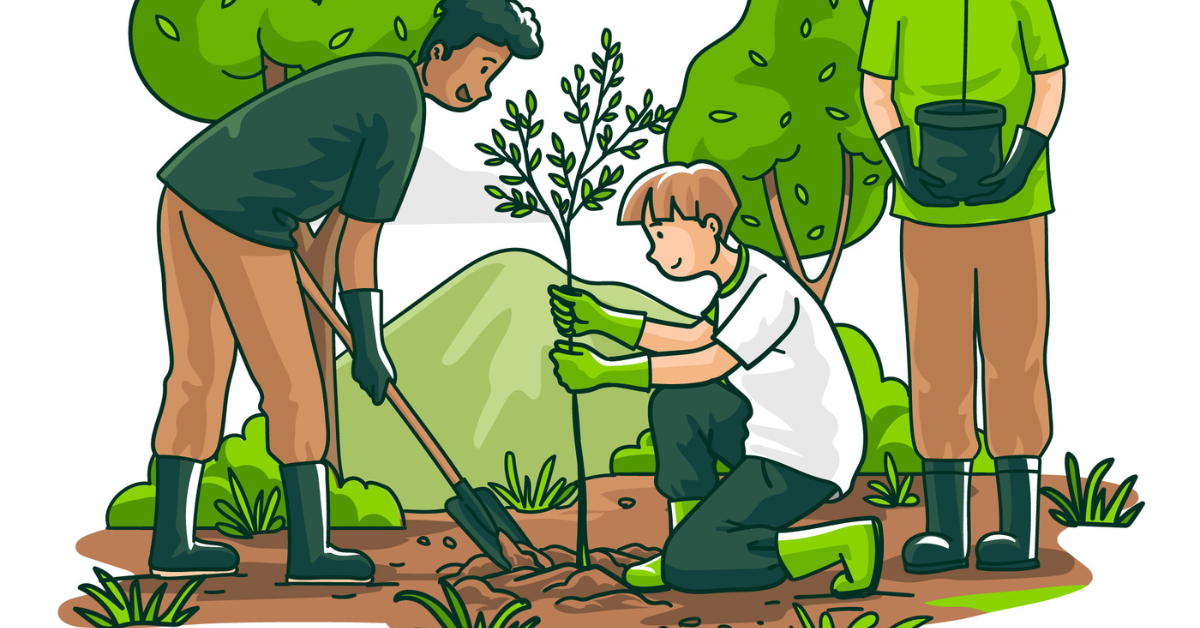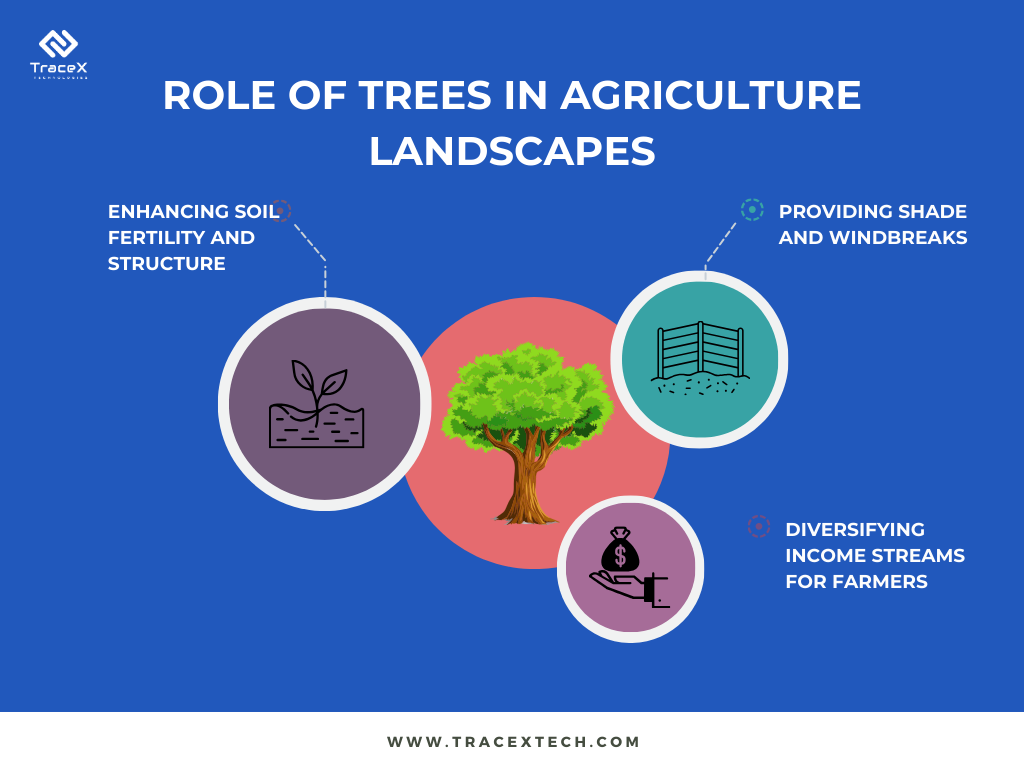Contact: +91 99725 24322 |
Menu
Menu
Quick summary: Discover the transformative potential of agroforestry in Indonesia as we explore the integration of trees into agricultural landscapes. From government policies to private sector collaborations, learn how promoting agroforestry can drive sustainable land use, biodiversity conservation, and rural development in Indonesia.

Agroforestry in Indonesia is important to enhance food security, biodiversity, and climate resilience while supporting the livelihoods of rural communities. Integrating trees into agricultural landscapes through agroforestry practices offers a sustainable approach to land use management in Indonesia. With its rich biodiversity and vast agricultural expanses, Indonesia stands to benefit greatly from the adoption of agroforestry, which harmonizes agricultural production with environmental conservation.
Agroforestry has significantly improved the livelihoods of numerous Indonesian farmers, particularly those operating on a small scale.
Agroforestry is a land use management system that integrates trees and shrubs into agricultural landscapes, combining agricultural crops or livestock with trees in mutually beneficial arrangements. This practice encompasses a wide range of systems, including alley cropping, silvopasture, and agroforestry home gardens, among others. Agroforestry promotes biodiversity, enhances soil fertility, conserves water, and provides multiple products and benefits from the same piece of land.
Agroforestry plays a crucial role in Indonesia due to its diverse agricultural and ecological landscapes. The country’s tropical climate and rich biodiversity provide favorable conditions for agroforestry practices, which have been practiced for centuries by indigenous communities. In Indonesia, agroforestry contributes to food security, income generation, environmental conservation, and climate change mitigation and adaptation. Small-scale farmers, who make up a significant portion of the population, benefit greatly from agroforestry by diversifying their income sources, improving soil health, and reducing vulnerability to climate-related risks such as droughts and floods. Moreover, agroforestry systems help conserve natural resources, protect watersheds, and promote biodiversity conservation by providing habitat for wildlife and supporting ecosystem services. Overall, agroforestry plays a vital role in sustainable agriculture and rural development in Indonesia, offering a multifaceted approach to addressing various social, economic, and environmental challenges.
Agriculture is a cornerstone of Indonesia’s economy, providing livelihoods for millions of people and contributing significantly to the country’s GDP. The agricultural sector in Indonesia is diverse, with a wide range of crops grown across various regions, including rice, palm oil, rubber, coffee, cocoa, and spices. Small-scale farming predominates, with many farmers practicing subsistence agriculture on small plots of land. However, large-scale commercial agriculture, particularly in the palm oil and timber industries, also plays a significant role in the country’s agricultural landscape.
Indonesian agriculture faces numerous environmental challenges, including deforestation, soil degradation, water pollution, and biodiversity loss. Deforestation, driven primarily by the expansion of agricultural land, particularly for palm oil and timber plantations, poses a significant threat to Indonesia’s forests and ecosystems. Soil degradation, exacerbated by unsustainable land management practices such as slash-and-burn agriculture and monoculture cropping, undermines agricultural productivity and food security. Water pollution from agricultural runoff, pesticide use, and improper waste disposal further degrades aquatic ecosystems and threatens human health. Biodiversity loss, resulting from habitat destruction and fragmentation, undermines the resilience of ecosystems and jeopardizes the long-term sustainability of agricultural systems.
Given the environmental challenges facing Indonesian agriculture, there is an urgent need for sustainable farming practices that promote the long-term health and resilience of ecosystems while supporting the livelihoods of farmers. Sustainable farming practices, such as agroforestry, organic farming, and integrated pest management, offer viable solutions to these challenges by promoting biodiversity, improving soil health, conserving water resources, and reducing greenhouse gas emissions. These practices not only enhance the sustainability and resilience of agricultural systems but also contribute to climate change mitigation and adaptation efforts. Moreover, sustainable farming practices align with international commitments to sustainable development, biodiversity conservation, and climate action, positioning Indonesia as a leader in responsible agriculture and environmental stewardship.
Agroforestry is a sustainable land use management system that integrates trees, crops, and/or livestock on the same piece of land, fostering ecological synergy and multiple benefits. The principles of agroforestry revolve around mimicking natural forest ecosystems while incorporating agricultural production. This involves strategically planting trees alongside agricultural crops or livestock, with the aim of enhancing ecosystem functions, conserving natural resources, and improving productivity.
Agroforestry encompasses a diverse range of systems tailored to specific environmental conditions, farming objectives, and socioeconomic contexts. Some common types of agroforestry systems include:

Indonesia has a rich tradition of agroforestry practices that have been cultivated by indigenous communities for centuries. Traditional agroforestry systems in Indonesia include:
1. Tembawang: A traditional agroforestry system practiced by the Dayak people of Borneo, which involves the rotational cultivation of rice in swidden fields interspersed with fruit and timber trees.
2. Sistema Tumpang Sari: A multi-layered agroforestry system practiced in Java and Bali, where annual crops, fruit trees, and timber trees are grown together in a synergistic arrangement, maximizing land productivity and biodiversity.
3. Ladang: A form of agroforestry practiced in Sumatra, where rubber, coffee, and cacao are intercropped with shade trees such as fruit trees and timber species, providing shade, soil protection, and additional income for farmers.
In recent years, there has been a resurgence of interest in modern agroforestry initiatives in Indonesia, driven by the need for sustainable land use practices and climate change mitigation. Some examples of modern agroforestry initiatives include:
1. Oil Palm Agroforestry: Integration of oil palm plantations with shade trees, cover crops, and diverse agroforestry species to promote biodiversity, soil health, and ecosystem resilience while maintaining oil palm productivity.
2. Community-Based Agroforestry: Collaborative efforts between government agencies, NGOs, and local communities to establish agroforestry systems on degraded lands, promoting food security, livelihood improvement, and environmental restoration.
3. Agroforestry Education and Research: Academic institutions and research organizations in Indonesia are conducting studies and pilot projects to explore the potential of agroforestry in enhancing agricultural sustainability, ecosystem services, and rural development.
There are numerous success stories and case studies highlighting the benefits of agroforestry practices in Indonesia. These include increased farm productivity, improved soil fertility, enhanced biodiversity, and resilient livelihoods for rural communities. Organizations such as the World Agroforestry Centre (ICRAF) and local NGOs are actively promoting agroforestry through capacity-building, knowledge-sharing, and policy advocacy, demonstrating the potential of agroforestry to address pressing socio-environmental challenges in Indonesia.
Agroforestry practices contribute to biodiversity conservation by creating diverse and complex habitats that support a wide range of plant and animal species. The presence of trees in agroforestry systems enhances habitat diversity, provides food and shelter for wildlife, and promotes ecological connectivity across landscapes. Agroforestry systems often harbor higher levels of species richness and genetic diversity compared to monoculture agricultural systems, making them important refuges for threatened and endemic species. By promoting biodiversity conservation, agroforestry helps to maintain ecosystem resilience, ecosystem services, and the long-term sustainability of agricultural landscapes.
Trees play a crucial role in mitigating climate change by sequestering carbon dioxide from the atmosphere and storing it in biomass and soils. Agroforestry systems contribute to carbon sequestration through the accumulation of carbon in tree biomass, roots, and soil organic matter. By integrating trees into agricultural landscapes, agroforestry helps to enhance carbon stocks, mitigate greenhouse gas emissions, and build climate resilience. Agroforestry practices such as alley cropping, silvopasture, and reforestation also help to reduce soil erosion, regulate water cycles, and buffer against extreme weather events, further enhancing climate resilience in agricultural systems.
Agroforestry offers numerous social and economic benefits for rural communities, including livelihood improvement, income diversification, and community empowerment. By integrating trees with agricultural crops or livestock, agroforestry provides additional sources of income from tree products such as fruits, nuts, timber, and non-timber forest products. This diversification of income streams helps to reduce farmers’ dependence on single crops and provides a safety net against market fluctuations and environmental risks. Moreover, agroforestry promotes community empowerment by fostering collective decision-making, knowledge-sharing, and cooperative resource management. By engaging local communities in agroforestry initiatives, rural development organizations and government agencies can enhance social cohesion, strengthen local economies, and promote sustainable land use practices.
1. Lack of Knowledge and Awareness:
Challenge: Many farmers may lack awareness of agroforestry practices or have limited access to information and training.
Technology Solution: Technology can provide accessible and interactive platforms for disseminating knowledge and training materials on agroforestry. Mobile applications, online courses, and webinars can reach a wide audience of farmers and extension workers, providing practical guidance on agroforestry techniques, benefits, and best practices.
2. Access to Resources and Inputs:
Challenge: Access to tree seedlings, technical expertise, and financial resources may be limited, particularly for small-scale farmers.
Technology Solution: Digital platforms can facilitate access to tree nurseries, seedling suppliers, and agroforestry experts. Online marketplaces and mobile apps can connect farmers with reliable sources of tree seedlings, equipment, and financing options. Additionally, remote sensing and GIS technologies can help identify suitable land for agroforestry and optimize resource allocation for tree planting initiatives.
3. Land Tenure and Policy Barriers:
Challenge: Land tenure insecurity and conflicting land-use policies may discourage farmers from adopting agroforestry practices.
Technology Solution: Blockchain technology can provide transparent and secure land tenure records, reducing disputes and uncertainties related to land ownership. Smart contracts and digital land registries can streamline the process of obtaining land-use permits and approvals for agroforestry projects, promoting legal compliance and land stewardship.
4. Monitoring and Management:
Challenge: Monitoring and managing agroforestry systems require regular observation, data collection, and decision-making.
Technology Solution: Remote sensing, drones, and satellite imagery can provide real-time monitoring of agroforestry plots, allowing farmers to assess vegetation growth, detect pest outbreaks, and monitor soil health. Sensor networks and IoT devices can collect environmental data, such as soil moisture and temperature, enabling precision management of agroforestry resources and inputs.
5. Market Access and Value Chains:
Challenge: Limited market access and fragmented value chains may hinder farmers’ ability to market agroforestry products effectively.
Technology Solution: Digital traceability and e-commerce platforms can connect agroforestry producers with buyers and consumers, enabling transparent transactions and fair pricing. Blockchain-enabled supply chain solutions can ensure the integrity and authenticity of agroforestry products, enhancing trust and marketability in domestic and international markets.
TraceX DMRV solutions revolutionize project management, baselining, and digital monitoring, reporting, and verification (DMRV) of agroforestry projects. By integrating advanced technologies such as blockchain, IoT, and remote sensing, TraceX enables seamless data collection, analysis, and reporting throughout the project lifecycle. From establishing baseline assessments to monitoring tree growth and environmental parameters, TraceX provides real-time insights and transparency, empowering stakeholders to make informed decisions and track project progress accurately. By streamlining data management and verification processes, TraceX enhances project efficiency, accountability, and compliance with sustainability standards, ultimately contributing to the success and scalability of agroforestry initiatives.
The Indonesian government plays a pivotal role in promoting agroforestry through policy support and incentive programs. Policies such as the National Agroforestry Development Program and the National Action Plan for Climate Change Mitigation and Adaptation recognize agroforestry as a key strategy for sustainable land use and climate resilience. Capacity building and extension services play a crucial role in equipping farmers with the knowledge and skills needed to implement agroforestry practices effectively. Government agencies, agricultural universities, and non-profit organizations offer training programs, workshops, and field demonstrations on agroforestry techniques, tree management, and sustainable land management practices. Collaboration between government agencies, NGOs, and private sector stakeholders is essential for scaling up agroforestry initiatives and leveraging resources and expertise. NGOs such as the World Agroforestry Centre (ICRAF) and Conservation International (CI) partner with local communities and government agencies to implement agroforestry projects, providing technical assistance, funding, and monitoring support.
In conclusion, promoting agroforestry in Indonesia holds immense potential for sustainable land use, biodiversity conservation, and rural development. Through government policies and incentives, capacity building efforts, and collaboration with NGOs and private sector stakeholders, Indonesia can harness the power of agroforestry to address pressing socio-environmental challenges while promoting economic prosperity for rural communities. By integrating trees into agricultural landscapes, Indonesia can enhance food security, mitigate climate change, and preserve its rich natural heritage for future generations. With continued commitment and collective action, agroforestry can serve as a cornerstone of Indonesia’s journey towards a more resilient, inclusive, and environmentally sustainable future.
